Instructions for growing radishes in a greenhouse in winter for sale and the profitability of this business
Radish - a great addition to any salad or appetizer. Vitamin roots are always in good demand, especially in winter, when the range of vegetables in stores is not as rich as in summer.
Radish is unpretentious in cultivation and early maturity, so some gardeners grow it in the cold season. In this article, we will tell you how to organize the cultivation of radishes in a greenhouse for sale in winter and achieve success.
The content of the article
What varieties of radish are suitable
For winter cultivation it is better to choose early ripening varieties, since the growing season is slower in winter. The ripening period for such varieties is 18-20 days, but in cold weather the growth of a vegetable can be delayed up to 30-35 days.
For greenhouse cultivation, varieties are chosen that are resistant to shooting, air humidity and lack of light.
The varieties are best suited: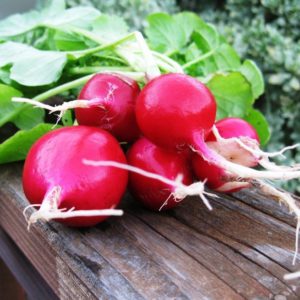
- 18 days - early variety, ripens in 18-20 days, resistant to cold, no arrows;
- Heat - resistant to shooting and temperature extremes, ripening period - 18-27 days;
- French breakfast - hardy, early maturing;
- Saksa - resistant to excessive moisture and shade;
- Presto - ultra early, harvest can be harvested as early as 16 days after landing, does not form arrows.
Preparatory stage
Radishes should not be planted next to cabbage, turnips or radishes to avoid common diseases. It is better to plant the radishes in their original place of growth of cucumbers, carrots, onions or garlic.
Selection and treatment of seeds
Before landing check the seed material for germination: pour it with water for 5-10 minutes and remove the floating empty seeds from the surface. Suitable specimens are dipped in a weak solution of potassium permanganate for a day. This not only reduces the risk of disease and pest infestation of radishes, but also stimulates plant growth.
Attention! If you purchased granulated or pelleted seeds, then processing is not necessary.
Soil preparation and greenhouses
Prepare the soil in the fall after harvesting in the greenhouse: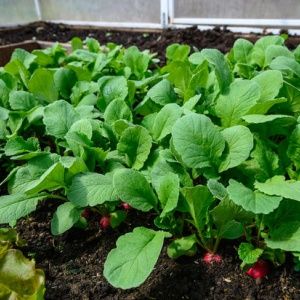
- They clean the soil from roots, branches and other debris.
- They dig up and loosen the soil.
- Fertilize with wood ash - 0.5 cups per 1 m².
- Humus is introduced - 3 kg per 1 m².
In winter, it will not work to grow radishes under a film, in cold weather it is done in a polycarbonate greenhouse.
The sun may not be enough for vegetables, therefore, for additional lighting in the greenhouse, lamps of the blue or red spectrum are hung, otherwise, instead of juicy root crops, flabby, tasteless roots will turn out or radishes will go to the arrow.
Heating methods
The heating system can be organized in several ways: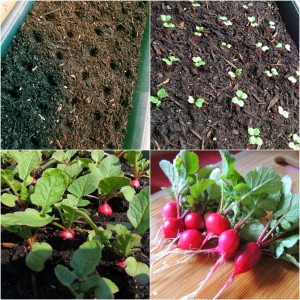
- Electric... Heating cable and protective screens are required. A protective mesh is placed at the bottom of the future bed, a cable is laid on top, which is covered with a mesh, it is covered with a layer of sand 5 cm thick and a layer of fertilized soil 20 cm thick.
- Water... Heating is carried out using water pipes, which are laid under the beds and heated with a boiler or titanium.
- Biological... All soil from the garden is removed to the bottom, a layer of fresh manure is placed on it to gradually release heat, a layer of nutrient soil 20 cm thick is poured on top.
Radiators or infrared heaters can be purchased to heat the greenhouse.
How to plant radishes
A few days before sowing, the soil is covered with plastic wrap to warm it up. After preparing the soil, furrows are made on its surface at a distance of 10 cm from each other, into which seeds are planted to a depth of 1.5 cm at a distance of 3-4 cm from each other. After planting, the furrows are watered with water.
Planting in autumn is carried out at a temperature not lower than + 10 ... + 12 ° C. For the emergence of seedlings, the temperature is maintained at + 16 ... + 18 ° С. When the first leaves appear, the temperature is lowered to + 8 ... + 10 ° С for three days, after which it is raised again to + 16 ... + 20 ° С.
Winter greenhouse radish care
Radish is a moisture-loving culture. It is more convenient to organize drip irrigation so as not to constantly water the vegetables. Manual watering is carried out 3-4 times a day as the soil dries up.
Do not overfill the plantings, otherwise the root crops will rot. Irrigation rate is 1 liter of water per 1 m². After it, the soil is loosened to provide oxygen access to the root crops and the room is ventilated for 10-15 minutes.
Important! With the emergence of seedlings, the frequency of watering is increased.
After sprouting, the radishes are thinned out, otherwise the roots will be small and tasteless. A distance of 3-4 cm is left between the shoots.
Humus or peat is added as an additional fertilizer.
If there is a sharp drop in temperature, the landings are protected with arcs covered with polyethylene or non-woven material.
Diseases and pests
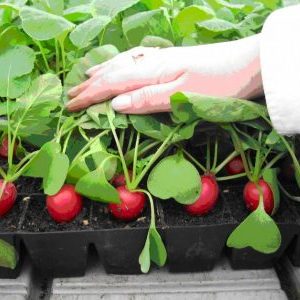
As a prophylaxis for the appearance of diseases and pests, the soil is treated after the emergence of seedlings: the plantings are watered with a solution of wood ash or they are poured into the aisles.
Airing, moderate watering and loosening the soil will help prevent the appearance of fungal diseases and root rot.
The most dangerous for radish are bacteriosis (small dark moist spots on the tops) and powdery mildew (yellow spots on the surface and gray "fluff" on the lower side of the leaf)... The preparations "Planriz", "Fitosporin-M", "Alirin-B" will help to cope with them.
If cruciferous fleas are found in the greenhouse (the leaf surface is eaten away), the plantings are treated with tobacco dust or crushed wood ash.
Harvesting
When harvesting, they are guided by the ripening period of the selected variety. It is not recommended to pull with it, as overgrown roots run the risk of becoming hard.
The collection of radish is carried out as follows: vegetables are watered in the morning, and they are harvested closer to lunch. Then the tops are cut off, but not at the root, but leaving tails 1 cm long. After cutting the tops, the radishes are washed from dirt and dried.
Storage
After drying the radish, it is laid on storage.
There are two storage methods:
- In plastic bags in the refrigerator for a month.
- In the cellar. For this, the crop is placed in boxes, the bottom of which is covered with polyethylene. Root vegetables are sprinkled on top with a mixture of peat and sand. This method prevents radish from rotting and is more suitable for long-term storage than the first.
The profitability of such a business
The advantage of a radish business is that you grow goods on your own plot, and such products are not taxed. If things go well and you register as an individual entrepreneur, you will be able not only to trade on your own, but also to supply vegetables to stores.
Council. When registering, indicate the field of activity - agricultural production. These entrepreneurs are supported by the state.
Approximate calculation of profit from a plot of 100 m²: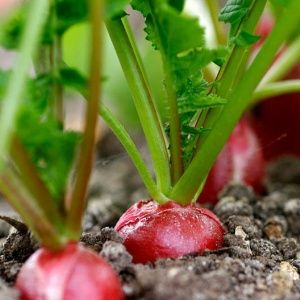
- There are 15 to 25 roots in a bunch of radishes (depending on size).
- Two such beams are approximately 1 kg.
- Up to 125 vegetables can be placed on 1 m².
- About 12,500 root crops can be grown over the entire area (if we consider that the germination rate is 90-95%, it turns out 11,250 root crops).
- The approximate number of bunches from the resulting number of root crops is 450.
- The average price of a bunch of radishes is 45 rubles. The cost of potentially grown root crops is 20,250 rubles.
- To calculate the net profit, it remains to deduct from the amount received the costs of seeds, fertilizers and gasoline, the organization of the greenhouse heating system.
Recommendations for maximum profit:
- increase the area of growing vegetables;
- choose varieties with excellent taste;
- to attract new customers, add exotic to the main varieties - for example, white or yellow radish;
- sell radishes on the eve of the holidays.
Conclusion
Growing radishes for sale is not difficult, but also not very profitable. It makes sense to start doing this business in the south of the country, as in the central and northern regions, heating costs will be too high, and there will simply be no profit. Everything is in your hands: act and you will succeed!